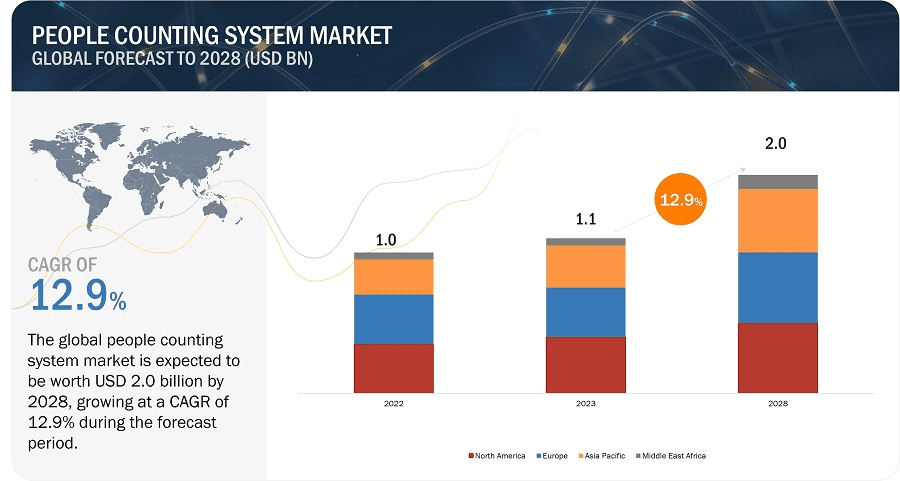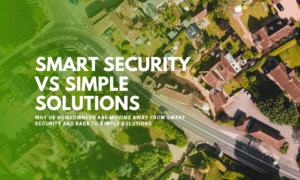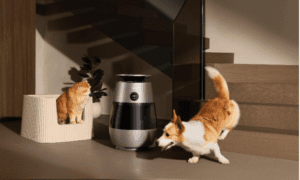According to the report “People Counting System Market by Type (Unidirectional, Bidirectional), Technology (Infrared Beam, Thermal Imaging, Video Based), Hardware (Thermal Cameras, Infrared Sensors, Fixed Cameras, Fixed Dome Cameras), Software, End User – Global Forecast to 2028″ , the global people counting system market size is expected to grow from USD 1.1 billion in 2023 to USD 2.0 billion by 2028, at a CAGR of 12.9%. The rising installation of people counting systems in libraries, retail stores, and transportation hubs as well as increasing implementation of people counting systems to track marketing effectiveness are the major driving factors for the growth of the people counting system industry.
Explore How People Counting Systems Work and Reasons of Rapid Expanding
People counting systems are electronic tools for measuring traffic flow and tracking visitor movement based on physical sensors. These sensors can be placed on doors, walls, or ceilings to track the number of people who enter or exit a particular area. The counting data collected from these sensors can be retrieved via a software program for analysis and reporting.
People counting systems have become an increasingly popular tool for businesses and organizations to gather valuable data on their foot traffic. According to the report mentioned in the first paragraph, the people counting systems market size growth can be attributed to several key factors, including the rising installation of people counting systems in libraries, retail stores, and transportation hubs. These businesses and institutions are recognizing the important role that people counting systems can play in optimizing operations and enhancing customer experiences.
For businesses seeking to improve profitability and overall performance, understanding customer behavior is essential. This is where the people counting systems come into play. By tracking critical information such as how many people enter your store, how long they stay, and which areas they visit frequently, you can get insights into customer behavior and make informed decisions regarding operational efficiency, staff allocation, and marketing strategies. People counting systems provide businesses with valuable data on customer behavior. This information can help you schedule staff effectively and optimize your store’s layout to ensure customer flow is smooth and efficient.
As the demand for accurate and reliable people counting systems continues to grow, it is likely that we will see further advancements in the technology and applications of these systems. Indeed, the people counting system industry is poised for continued growth and innovation in the years to come.
In this article, we will introduce 6 most popular sensors used for people counting systems as well as its own set of features and benefits of each sensor. Let’s take a closer look at each one.
6 Different Sensors Used For People Counting Systems
## 1. Thermal Sensor Technology
Thermal sensors use heat signatures to detect the presence of people in a specific area, without capturing identifiable visual information. This non-intrusive nature can be beneficial in various settings where maintaining privacy or avoiding physical contact is important. Thermal sensors can work effectively in different lighting conditions, including low-light or complete darkness. This makes them suitable for applications such as monitoring people flow in dimly lit areas or during nighttime.
Despite of the advantages outlined, the accuracy of thermal-sensor-based people counting system can still be susceptible to environmental factors such as temperature changes, drafts, or the presence of other heat-emitting sources. Additionally, challenges may arise when individuals overlap. The overlapping heat signatures may be detected as a single entity, leading to undercounting or overcounting depending on the system’s algorithms.
## 2. Active Infrared Sensor Technology
In an Active infrared counting system, an emitter and a receiver are typically placed on opposite sides of a pathway or entrance. The emitter continuously emits an infrared beam towards the receiver. When a person passes through the pathway and interrupts the beam, the receiver detects the interruption and registers a count. Active infrared counting system is also called infrared beam counting, or infrared break beam.
Compared to some other people counting technologies, active infrared system offers a relatively affordable solution to obtain people count data. It is also a non-intrusive method that respects privacy and minimizes any impact on the individuals being counted.
As talked, active Infrared systems rely on an uninterrupted line-of-sight between the emitter and receiver, so any obstruction, such as objects or people blocking the beams, can result in missed counts or inaccurate data. It also has the similar overlapping issue mentioned in the former part of thermal sensor.
## 3. Video Camera Sensor Technology
Video camera sensors leverage sophisticated algorithms to analyze video footage and identify the presence of people. By tracking the flow of people, video camera sensors can offer detailed analytics by capturing additional information such as dwell time, heatmaps, or demographics. This data is valuable for understanding customer behavior, optimizing store layouts, and making informed business decisions.
However, the widespread use of video camera sensors raises serious privacy concerns in today’s context. Individuals may feel uncomfortable being constantly monitored.
Additionally, video camera sensors can be affected by lighting conditions, shadows, or environmental factors such as glare or reflections.
## 4. Wi-Fi Sensor Technology
Wi-Fi sensors work by detecting the unique signals emitted by mobile devices, such as smartphones and tablets. By collecting and analyzing this data, retailers can gain insight into the number of people present in a specific area, as well as their demographics and behavior.
Since Wi-Fi sensor people counting systems rely absolutely on the presence and availability of Wi-Fi signals, for Wi-Fi dead zones or weak signals in certain areas, or individuals who do not have Wi-Fi-enabled devices, the accuracy and reliability of the people counting data will be impacted.
##5. Time-of-Flight Camera Technology
The Time-of-flight camera technology, also called ToF camera, uses light pulses and sensors to measure the distance between the camera and the surrounding objects. This technology captures images in real-time, and provides accurate counting by using depth sensing data.
(Photos link: https://www.vzense.com/case/people-counting-system)
Furthermore, the depth perception not only enables more accurate differentiation between individuals, reducing the likelihood of miscounts or false detections, but enables precise detection and tracking of individuals with additional information such as dwell time, heatmaps, or demographics provided.
Time-of-flight camera systems are less affected by environmental factors such as shadows, lighting variations, or reflections compared to traditional cameras. This enhances the reliability and accuracy of people counting even in challenging environments such as under strong sunlight or with limited lighting.
Unlike video cameras that capture high-resolution images or video, Time-of-Flight cameras primarily focus on depth sensing and distance measurement rather than capturing detailed visual information so it’s almost no way to distinguish individuals via the depth data provided by ToF cameras. This means that the collected data is typically anonymized and does not include personally identifiable information (PII) of individuals.
Vzense Technology, focused on Time-of-flight camera technology for 7years, has launched pulse iToF camera DCAM series and continuous wave iToF camera DS series. For people counting, queue management as well as gesture perception, DCAM series is one of the best sensor candidates, enhancing the ability for long-distance measurement and stronger environmental robustness.
(People Counting ToF Camera DCAM550)





























